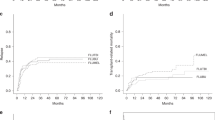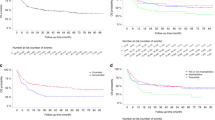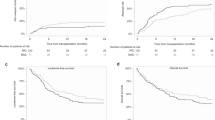Summary:
To assess the role of allogeneic stem cell transplantation (SCT) after reduced-intensity conditioning (RIC) in acute leukaemias, we retrospectively compared 25 patients with acute lymphoblastic leukaemia or acute myelogenous leukaemia after RIC to a historical group of 50 matched controls after high-dose conditioning. Engraftment, acute GvHD and severe infections were comparable in both groups. During the observation period, 1/25 patients (4%) after RIC and 14/50 (28%) after standard SCT died due to transplant-related causes; cumulative nonrelapse mortality (NRM) was 4% after RIC and 24% after standard SCT (P=0.029). In total, 15/25 patients (60%) relapsed after RIC and 20/50 (40%) after standard SCT; probability of disease-free survival (DFS) at 3 years was 43% after RIC and 49% after standard SCT (NS). Overall survival (OS) was 40% after RIC and 37% after standard SCT (NS). Stage of disease, cytogenetic risk profile, acute and chronic GvHD, chimerism status at day 90 and severe infections after transplantation were risk factors with significant impact on DFS and/or OS. In retrospective analysis, patients with acute leukaemias who receive RIC because of contraindications against standard SCT have a comparable outcome to standard SCT, but the higher relapse rate warrants further studies.
This is a preview of subscription content, access via your institution
Access options
Subscribe to this journal
Receive 12 print issues and online access
$259.00 per year
only $21.58 per issue
Buy this article
- Purchase on Springer Link
- Instant access to full article PDF
Prices may be subject to local taxes which are calculated during checkout




Similar content being viewed by others
References
Storb R, Yu C, Barnett T et al. Stable mixed haematopoietic chimerism in dog leukocyte antigen-identical littermate dogs given lymph node irradiation before and pharmacologic immunosuppression after marrow transplantation. Blood 1999; 94: 1131–1136.
McSweeney PA, Niederwieser D, Shizuru JA et al. Haematopoietic cell transplantation in older patients with haematologic malignancies: replacing high-dose cytotoxic therapy with graft-versus-tumor effects. Blood 2001; 97: 3390–3400.
Slavin S, Nagler A, Naparstek E et al. Non-myeloablative stem cell transplantation and cell therapy as an alternative to conventional bone marrow transplantation with lethal cytoreduction for the treatment of malignant and non malignant haematological diseases. Blood 1998; 91: 756–763.
Giralt S, Estey E, Albitar M et al. Engraftment of allogeneic haematopoietic progenitor cells with purine analog-containing chemotherapy: harnessing graft-versus-leukaemia without myeloablative therapy. Blood 1997; 89: 4531–4536.
Childs R, Clave E, Contentin N et al. Engraftment kinetics after nonmyeloablative allogeneic peripheral blood stem cell transplantation: full donor T-cell chimerism precedes alloimmune responses. Blood 1999; 94: 3234–3241.
Spitzer TR, McAfee S, Sackstein R et al. Intentional induction of mixed chimerism and achievement of antitumor responses after nonmyeloablative conditioning therapy and HLA-matched donor bone marrow transplantation for refractory haematologic malignancies. Biol Blood Marrow Transplant 2000; 6: 309–320.
Massenkeil G, Nagy M, Lawang M et al. Reduced intensity conditioning and prophylactic DLI can cure patients with high-risk acute leukaemias if complete donor chimerism can be achieved. Bone Marrow Transplant 2003; 31: 339–345.
Bornhäuser M, Kiehl M, Siegert W et al. Dose-reduced conditioning and allogeneic haematopoietic stem cell transplantation from unrelated donors in 44 patients. Clin Cancer Res 2001; 7: 2254–2262.
Chakraverty R, Peggs K, Chopra R et al. Limiting transplantation-related mortality following unrelated donor stem cell transplantation by using a nonmyeloablative conditioning regimen. Blood 2002; 99: 1071–1078.
Junghanss C, Boeckh M, Carter RA et al. Incidence and outcome of cytomegalovirus infections following nonmyeloablative compared with myeloablative allogeneic stem cell transplantation, a matched control study. Blood 2002; 99: 1978–1985.
Or R, Shapira MY, Resnick I et al. Nonmyeloablative allogeneic stem cell transplantation for the treatment of chronic myeloid leukaemia in first chronic phase. Blood 2003; 101: 441–445.
Mielcarek M, Martin PJ, Leisenring W et al. Graft-versus-host disease after nonmyeloablative versus conventional haematopoietic stem cell transplantation. Blood 2003; 102: 756–762.
Parker JE, Shafi T, Pagliuca A et al. Allogeneic stem cell transplantation in the myelodysplastic syndromes: interim results of outcome following reduced-intensity conditioning compared with standard preparative regimens. Br J Haematol 2002; 119: 144–154.
Dreger P, van Biezen A, Brand R et al. Reduced-intensity conditioning lowers treatment-related mortality (TRM) of allogeneic stem cell transplantation (SCT) for CLL: a retrospective trial on 448 patients. Blood 2003; 102: 197a.
Sureda A, Robinson S, de Elvira CR et al. Non-myeloablative allogeneic stem cell transplantation significantly reduces transplant-related mortality in comparison with conventional allogeneic transplantation in relapsed or refractory Hodgkin's disease: results of the European Group for Blood and Marrow Transplantation. Blood 2003; 102: 198a.
Diaconescu R, Flowers CR, Storer B et al. Morbidity and mortality with nonmyeloablative compared with myeloablative conditioning before haematopoietic cell transplantation from HLA-matched related donors. Blood 2004; 104: 1550–1558.
Gratwohl A, Baldomero H, Passweg J et al. Increasing use of reduced intensity conditioning transplants: report of the 2001 EBMT activity survey. Bone Marrow Transplant 2002; 30: 813–831.
Arnold R, Massenkeil G, Bornhäuser M et al. Nonmyeloablative stem cell transplantation in adults with high-risk ALL may be effective in early but not in advanced disease. Leukaemia 2002; 16: 2423–2428.
Massenkeil G, Nagy M, le Coutre P et al. Nonmyeloablative stem cell transplantation in patients with ALL and AML results in low nonrelapse mortality despite high rate of infections and GVHD. Haematol J 2004; 5: 395–402.
Ascioglu S, Rex J, de Pauw B et al. Defining opportunistic invasive fungal infections in immunocompromised patients with cancer and haematopoietic stem cell transplants: an international consensus. Clin Infect Dis 2002; 34: 7–14.
Gökbuget N, Hoelzer D, Arnold R et al. Treatment of adult ALL according to protocols of the German multicenter study group for adult ALL (GMALL). Haematol Oncol Clin N Am 2000; 14: 1307–1325.
Visani G, Bernasconi P, Boni M et al. The prognostic value of cytogenetics is reinforced by the kind of induction/consolidation therapy in influencing the outcome of acute myeloid leukaemia – analysis of 848 patients. Leukaemia 2001; 15: 903–909.
Glucksberg H, Storb R, Fefer A et al. Clinical manifestations of graft-versus-host disease in human recipients of marrow from HLA-matched sibling donors. Transplantation 1974; 18: 295–304.
Shulman HM, Sullivan KM, Weiden PL et al. Chronic graft-versus-host syndrome in man: a clinicopathological study of 20 long-term Seattle patients. Am J Med 1980; 69: 204–217.
ACCP/SCCM. Consensus conference. Crit Care Med 1992; 20: 864–874.
Hughes WT, Armstrong D, Bodey GP et al. 2002 guidelines for the use of antimicrobial agents in neutropenic patients with cancer. Clin Infect Dis 2002; 34: 730–751.
Centre for Disease Control and Prevention, Infections Disease Society of America, American Society of Blood and Marrow Transplantation. Guidelines for preventing opportunistic infections among hematopoietic stem cell transplant recipients. Biol Blood Marrow Transplant 2000; 6: 659–734.
Kaplan EL, Meier P . Nonparametric estimation for incomplete observations. J Am Stat Assoc 1958; 53: 457–481.
Schaemper M, Smith TL . A note on quantifying follow-up in studies of failure time. Control Clin Trials 1996; 17: 343–346.
Cox DR . Regression models and life tables. J Roy Stat Soc B 1972; 34: 187–220.
Bader P, Klingebiel T, Schaudt A et al. Prevention of relapse in pediatric patients with acute leukaemias and MDS after allogeneic SCT by early immunotherapy initiated on the basis of increasing mixed chimerism: a single center experience of 12 children. Leukaemia 1999; 13: 2079–2086.
Mossad SB, Avery RK, Longworth DL et al. Infectious complications within the first year after nonmyeloablative allogeneic peripheral blood stem cell transplantation. Bone Marrow Transplant 2001; 28: 491–495.
Kolb HJ, Schattenberg A, Goldman JM et al. Graft-versus-leukaemia effect of donor lymphocyte transfusions in marrow grafted patients. Blood 1995; 86: 2041–2050.
Marks D, Lush R, Cavenagh J et al. The toxicity and efficacy of donor lymphocyte infusions given after reduced-intensity conditioning allogeneic stem cell transplantation. Blood 2002; 100: 3108–3114.
Mohty M, Faucher C, Vey N et al. High rate of secondary viral and bacterial infections in patients undergoing allogeneic bone marrow mini-transplantation. Bone Marrow Transplant 2000; 26: 251–255.
Hill GR, Crawford JM, Cooke KR et al. Total body irradiation and acute graft-versus-host disease: the role of gastrointestinal damage and inflammatory cytokines. Blood 1997; 90: 3204–3213.
Martin PJ, Schoch G, Fisher L et al. A retrospective analysis of therapy for acute graft-versus-host disease: initial treatment. Blood 1990; 76: 1464–1472.
Khouri IF, Keating M, Korbling M et al. Transplant-lite: induction of graft-versus-malignancy using fludarabine-based nonablative chemotherapy and allogeneic blood progenitor-cell transplantation as treatment for lymphoid malignancies. J Clin Oncol 1998; 16: 2817–2824.
Appelbaum FR . Allogeneic haematopoietic stem cell transplantation for acute leukaemia. Semin Oncol 1997; 24: 114–123.
Greinix HT, Nachbaur D, Krieger O et al. Factors affecting long-term outcome after allogeneic haematopoietic stem cell transplantation for acute myelogenous leukaemia: a retrospective study of 172 adult patients reported to the Austrian Stem Cell Transplantation Registry. Br J Haematol 2002; 117: 914–923.
Author information
Authors and Affiliations
Corresponding author
Rights and permissions
About this article
Cite this article
Massenkeil, G., Nagy, M., Neuburger, S. et al. Survival after reduced-intensity conditioning is not inferior to standard high-dose conditioning before allogeneic haematopoietic cell transplantation in acute leukaemias. Bone Marrow Transplant 36, 683–689 (2005). https://doi.org/10.1038/sj.bmt.1705123
Received:
Accepted:
Published:
Issue Date:
DOI: https://doi.org/10.1038/sj.bmt.1705123
Keywords
This article is cited by
-
Extra-medullary recurrence of myeloid leukemia as myeloid sarcoma after allogeneic stem cell transplantation: impact of conditioning intensity
Bone Marrow Transplantation (2021)
-
Comparison of reduced-intensity conditioning regimens in patients with acute lymphoblastic leukemia >45 years undergoing allogeneic stem cell transplantation—a retrospective study by the Acute Leukemia Working Party of EBMT
Bone Marrow Transplantation (2020)
-
Reduced Intensity Conditioning Allogeneic Hematopoietic Stem Cell Transplantation for Acute Lymphoblastic Leukemia; Current Evidence, and Improving Outcomes Going Forward
Current Hematologic Malignancy Reports (2018)
-
Who Should Receive a Transplant for Acute Lymphoblastic Leukaemia?
Current Hematologic Malignancy Reports (2017)
-
Long-term survival after allogeneic haematopoietic cell transplantation for AML in remission: single-centre results after TBI-based myeloablative and non-myeloablative conditioning
Bone Marrow Transplantation (2013)



